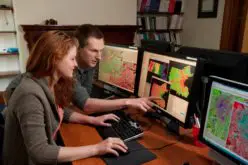Geospatial Analysis in Rubbish Collection Efficiency
Understanding the impact of geospatial analysis in rubbish collection is fundamental for all cities and the environment. From improving service delivery to promoting sustainability, the benefits are numerous. This article takes a deep dive into how geospatial technology is revolutionizing waste management, boosting efficiency and creating tidier, healthier communities.
Definition of Geospatial Analysis
In its simplest form, geospatial analysis involves studying data tied to specific locations on earth. This scientific method aids in the understanding and interpretation of geographic patterns and relationships. In rubbish collection, this means tracking waste generation and disposal as it correlates to different locations.
Geospatial analysis involves using geographical systems (GIS) and tools like GPS for data collection. This information aids in creating concise maps that visualize waste management activities. By displaying spatial data graphically, stakeholders can make more informed decisions regarding rubbish collection strategies and routes.
Importance of Rubbish Collection
Efficient and consistent rubbish collection is a critical civic service for sustaining public health and safety. The aesthetic appeal of clean neighborhoods is just one benefit of an effective waste management regime. Mitigating the spread of refuse helps control vermin and insect populations, reducing disease transmission risks among urban residents.
Moreover, as our consumption and waste generation grows, so too does the volume of potentially hazardous byproducts like electronic waste and biological contaminants from food scraps. Without proper containment and disposal, these materials pose major environmental and health dangers for the community. Reliable Manly rubbish removal services are thus essential for upholding standards of cleanliness and wellbeing across our cities.
Rubbish Removal Services in Manly
In Australia cities like Manly, efficient garbage disposal methodologies have redefined rubbish removal services. For instance, GIS has made scheduling more robust, allowing companies to streamline operations. Consequently, customers receive a reliable Manly rubbish removal service without any delays or inconveniences.
Just as importantly, geospatial analysis aids in route optimization. By analyzing routes digitally, drivers can avoid traffic and reduce fuel consumption, resulting in reduced operating costs. Companies can then pass these savings to customers, facilitating more affordable rubbish removal services.
How Geospatial Analysis Improves Efficiency
Geospatial analysis plays a crucial role in enhancing rubbish collection efficiency. For starters, it simplifies data interpretation by visualizing complex geographical data.
By superimposing waste generation data over city maps, it becomes easier to identify areas with higher waste production rates. Authorities can then concentrate their efforts on these spots, ensuring optimal resource usage. Moreover, GIS applications enable real-time tracking of garbage trucks which helps reduce delays and improves service delivery.
Application of GIS in Rubbish Collection
GIS technology is indispensable when it comes to modern waste management. Through this system, rubbish collection experts can perform spatial queries and produce layered maps that accurately represent the distribution of waste across a certain area.
The ability to visualize waste distribution patterns significantly benefits planning and decision-making processes in the waste management industry. Whether for scheduling regular pickups or organizing city-wide cleanups, GIS has proven invaluable in supporting efficient and timely service delivery.
Role of Geospatial Technology
Geospatial technologies are transforming how people approach rubbish disposal and recycling. They offer timely, geographic data essential for pinpoint accuracy during collection while ensuring appropriate disposal methods based on geographic location attributes.
These technologies also enhance communication between different stakeholders in waste management – from regional authorities and collection teams to recycling facilities. Timely information sharing encourages efficient coordination and effective problem-solving strategies, driving the overall efficiency of rubbish collection processes.
Geocoding in Rubbish Collection
Geocoding plays a crucial role in the effective allocation of resources in waste management. It involves assigning geographic coordinates to specific locations, thus creating a detailed map of the service area. This allows rubbish removal companies to coordinate their movements better and respond more effectively to changes.
With the help of geocoding, areas requiring urgent attention can be identified with precision. Furthermore, it facilitates route optimization efforts, ensuring that vehicles take the most efficient path to their destinations, leading to fuel and time savings.
GIS Mapping for Waste Management
GIS mapping is integral to waste management, as it provides a way to visualize geographical data and understand spatial relationships better. It lends insight into waste production at different points in the city, helping agencies streamline their collection schedules based on local needs.
By layering various data sets within a GIS application—for instance, demographic statistics, land use information, and waste volume data—analysts can identify patterns that influence waste production levels. They can also use these insights to craft targeted strategies that improve rubbish collection efficiency.
Eco-friendly Benefits of Effective Rubbish Collection
Proper rubbish collection confers significant environmental gains beyond clean streets. Safely containing waste cuts risks linked to pollution and contamination that disrupt local ecosystems. This preserves natural habitats in a balanced state.
Efficient management also diverts recyclables and organic waste towards renewed utility through industrial reprocessing and compost harvesting. Diverting waste from landfills has climate value through lowered emissions and conserved habitats by avoiding expanding dump sites.
Overall, comprehensive rubbish collection systems are pivotal contributors towards environmental sustainability for urban areas. Enhancing operational efficiency generates natural capital returns that benefit communities today and safeguard viability for tomorrow.
Future of Geospatial Technology in Waste Management
As urbanization escalates globally, finding intelligent ways to manage humanity’s soaring waste imprint will grow more urgent. Geospatial analytics and technology will remain firmly at the nucleus of these efforts to drive sustainability through increased operational efficiency, informed planning, and continuous infrastructure modernization.
Advanced applications like sensor grids, autonomous collection bots, and AI-powered forecasting software will become increasingly mainstream. These innovations promise enhanced accuracy in predicting localized waste patterns and recommending optimized collection schedules. Integrating smart predictive tools with digitized geospatially-aware routing systems enables the next level of intelligent, demand-driven waste extraction.
The result is dramatically leaner collection protocols by companies like Same Day Rubbish Removal. They will maximize fleet usage while minimizing associated emissions. As cities grow upwards and outwards, geospatial technology will serve as the keystone upholding sustainable, resilience-based waste management for future generations.
Critical Success Factors for Geospatial Analysis Adoption
To fully capitalize on geospatial analysis’ advantages for streamlining rubbish collection, a municipality must rally around some fundamental success prerequisites.
Firstly, sustained investments into developing high-fidelity geospatial datasets are non-negotiable. An abundance of accurate, real-time location data gives waste analytics its strategic power. Governments play a key role here through digital infrastructure development funds directed towards sensor grids, internet-of-things connectivity, and open geospatial data platforms.
Extensive reskilling programs also need to run in parallel. Workforces adept in handling spatial data tools and interpreting complex geospatial outputs do not materialize overnight. For lasting success, solid knowledge transfer frameworks must enable rubbish collectors, administrators, and route optimizers to all exploit location intelligence confidently.
Lastly, continuously iterating on collection protocols to incorporate geospatial innovations remains vital, even after initial implementations. As promising technologies emerge and data capture techniques improve, protocols must stay nimble to realize efficiency gains. Maintaining a test-and-learn approach ensures geospatial offerings translate into positive service enhancements for the community.
To Recap
Geospatial analysis has been transformative for global civic waste management. Location-aware tools like GIS break down barriers to visualizing waste distribution patterns across neighborhoods that long hindered optimizations. Sensor grids and AI now bring predictive precision to waste generation models. Together these technical enablers promise continued upwards efficiency for collection crews.
But work remains to unlock geospatial technology’s full disruption potential. Though some data and adoption barriers persist currently, we will likely witness their erosion through pioneering government and private sector efforts in coming years. Soon smart infrastructure and intelligent analytics will redefine the waste management value chain. And geospatial systems will remain the integral base enabling sustainable rubbish removal at scale for future smart cities.











